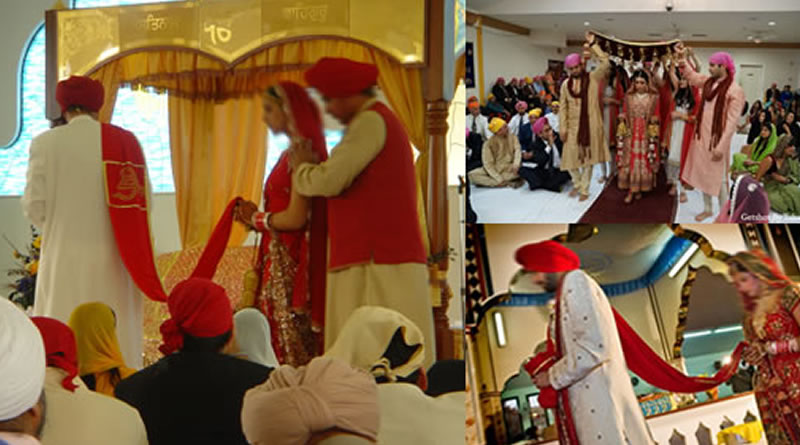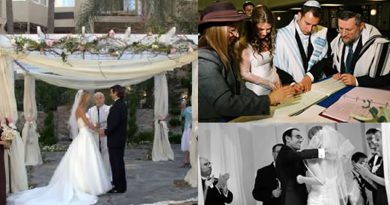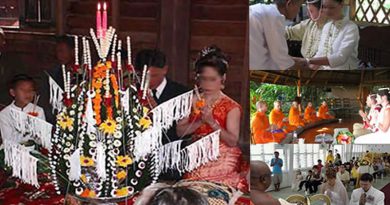Sikh Wedding and its traditional customs and rituals!
Sikh wedding is very simple and adheres to the religious practices. It is held in Gurudwara in front of Guru Granth Sahib.
GahoiMumbai.com is delighted to provide an insight to these Sikh traditions…
Sikh weddings are also relatively elaborate and extend over a time period of one week. But, they are not as pompous and showy as Hindu marriages. Sikh wedding is very simple and adheres to the religious practices. It is held in Gurudwara in front of Guru Granth Sahib. The customs and rituals form an integral part of the bridal ceremony. There are many customs which take place one week in advance.
The rituals that the Sikhs follow during their bridal ceremonies are similar to those practised by the Hindus. One important difference is that while the Hindus use Vedic texts the Sikhs use their sacred book, AdiGranth (also called Guru Granth Sahib).
The rituals are performed before, during and after the marriage ceremony and include interchange of gifts, jewellery and clothes amongst the two families. Customs and rituals take place in both families and are an integral part of the marriage.
With a small but significant population the Sikh community have made their mark on India’s socio- cultural horizon. The Sikh wedding customs that are generally performed in Gurudwaras, in the presence of preacher, family, friends and relatives, exudes great charm and festivities. The bridal ceremony that lasts for a week offers a great chance for food and feast that are hallmark of Sikh marriages.
Pre Wedding Rituals in Sikh Wedding:
A ceremony of Bliss – A pre wedding ritual:
The Sikhs refer to a wedding as anandkaraj or a ritual of bliss. The shopping for the wedding begins with the purchase of Rumalla Sahib – a set of four pieces of cloth that are customarily embroidered and are used to cover the Granth Sahib. The rest of the shopping is done only after this. The bride`s maternal grandparents and uncles also spend for the wedding on clothes and jewellery. They also host one meal on the occasion. This is publicly acknowledged as their contribution to the marriage.
Tilak ceremony – A pre wedding ritual:
The first pre wedding ritual is the engagement or the Tilak ceremony. The bhaiji or the preacher of the Gurudwara recites hymns, offers a date to the groom and applies tilak on his forehead. After this ceremony gifts are exchanged between both the families.
Chura ceremony – A pre wedding ritual:
In the Chura ceremony, which is held at the bride’s home. Here, the maternal uncle or aunt of the bride gives red and white bangles to her for wearing. Silver and gold ornaments are tied to the bangles, called Kalirein. ‘Maiya’ is the custom wherein the bride and the groom are not allowed to leave their house for some time before wedding.
Gana – A pre wedding ritual:
In the Gana ritual, wherein a red thread is tied on the right wrist of the groom and on the left wrist of the bride. This is considered to protect them from ill omen.
Vatna ceremony – A pre wedding ritual:
Just few days before marriage, Vatna ceremony is performed, in which vatna a scented powder made of barley flour, turmeric and mustard oil is applied to the couple. This is followed by a ceremonial bath.
Jaggo Ceremony – A pre wedding ritual:
The ritual of jaggo is again an event to which only close relatives and friends are invited. This usually takes place in the late hours of the night before the marriage. The maternal relatives of the bride assemble the night prior to the wedding. They decorate a copper vessel, called gaffar, with diyas (lamps) made of atta (wheat flour). They light these lamps with mustard oil wicks. The bride’s maternal aunt (mami) carries this vessel on her head. Another one of the ladies carries a long stick with ghungroos (small bells) tied on it and the ladies then visit the houses of their relatives in the village. In cities too, this custom is followed, but as the distances are large, the ladies travel by a vehicle. They are welcomed at every house and served sweets. The ladies sing and perform giddha, a traditional dance. The family that they visit usually pours some oil into the diyas.
Mehendi ceremony – A pre wedding ritual:
On the eve of the wedding, Mehendi ceremony is organized. In this, mehndi is applied on the hands and feet of the bride.
Gharoli ceremony – A pre wedding ritual: Gharoli is another pre wedding ritual, wherein the water from Gurdwara is fetched in an earthen pot for the ritual bath of the groom.
Wedding Rituals and Traditions in Sikh Wedding:
kharecharna ceremony – A wedding day ritual:
On the day of the wedding, in the morning, the groom`s sister-in-law and other female relatives go to a gurduwara and fill a gharoli (earthen pitcher) with water. This water is used to bathe the groom during the kharecharna ceremony. The groom is made to sit on a stool for his bath and four girls hold a cloth to his head. A similar bathing ritual is performed at the bride`s house as well.
After the bridal bath, the bride is made to wear the chura – 21 red and white bangles. Then, her sisters and friends tie kalerien – golden metal plates – to her bangles. She wears her bridal attire, which is a heavily embroidered salwar-kameez or lehenga-chunni. She wears a tikka (a hair ornament) in the parting of her hair and a nath (nose-ring) on her nose. The other jewels that Sikh brides wear include chaunk- a round head ornament made of gold or silver, kaintha – a gold necklace (like a choker), thick bangles called gokhru and pajeb or silver anklets.
In the meantime the groom gets ready to leave for his bride`s house. Usually he wears a brocade achkan (long coat). The groom and the male members of his family wear pink turbans. When the groom is ready to leave, his brother`s wife (bhabhi) applies surma (kohl) to his eyes and the groom gives her money as a token of his gratitude. After this ceremony, referred to as surmapawai, the groom leaves for the bride`s house on horseback, accompanied by his friends and relatives. This procession is called baraat.
The baraat arrives at the bride`s house amongst music, singing and dancing. The male members of the bride`s family welcome the baraat. This reception is called milni. A raagi (professional bard) sings shabad or the holy verse. The members of both families interchange garlands and gifts. The groom is taken in-doors and this is the time for the bride`s sisters and friends to engage him in a session of light- hearted banter.
A Sikh marriage usually takes place before noon. The families of the bride and the groom assemble at the gurudwara. Raagis sing asa di var or the morning hymn. Then the couple is made to sit in front of the AdiGranth. A priest first tells them about the obligations of married life. Then he sings the hymns of marriage from the Granth Sahib. During lawaan, the groom and the bride each hold one end of the scarf. The groom leads the bride around the Granth Sahib. At the end of the fourth round, the groom and the bride are pronounced husband and wife. All those assembled bless the couple and give them shagun or gifts in the form of money. A feast follows the ceremony of lawaan.
The wedding customs are quite brief in Sikhs. On the main day, a flower veil is tied to the groom’s forehead, by his sisters. A currency garland also beautifies his neck. This is followed by Milni ceremony, in which both the families meet at the bride’s place. They then attend the Gurudwara kirtan where shabads are sung and ardaas are recited. After this, the bride and the groom circle around the Guru Granth Sahib and seek blessings.
Post Wedding Rituals in Sikh Wedding:
After the bridal ceremony at the Gurudwara, the bride parts from her family. This is what the Vidaai ceremony is all about. The bride’s family bids her a tearful farewell as she throws back handful rice over her shoulders. The bride is carried to her husband`s house in a doli, or palanquin. But this custom is rarely followed these days. Upon her arrival, the groom`s family welcomes the bride and gives her mukhdekhai or money to behold her. Usually, the groom and his mother, give the bride jewellery as mukhdekhai. This is followed by a reception party or grand feast organized by the groom’s family. This is organized in order to welcome the new member in the family and to formally introduce her to family and friends.
The couple visit the bride`s parental home a day after the marriage. A welcome feast is held in their honour and the bride and the groom are given gifts.
Special Features of Sikh Wedding:
Rich homages are paid to the Guru Granth Sahib – the book containing holy verses, which is considered the 10th Guru. The bride is draped up in Red is and the groom adorns a sword usually ornamentally decorated at the time of the wedding.
If you need any help regarding Sikh wedding ceremony or Sikh Wedding Management, please leave your message about your dates, ideas and budget plans at our Wedding Help Centre.
All this information is free and only for informational purpose.




